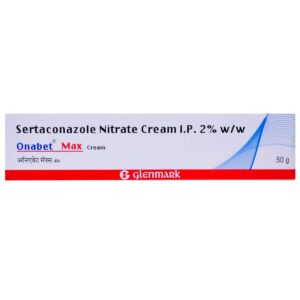DICLOFENAC + SERTACONAZOLE NITRATE
Diclofenac: Diclofenac is a nonsteroidal anti-inflammatory drug (NSAID) that is commonly used to relieve pain, inflammation, and swelling. It belongs to a class of drugs known as cyclooxygenase inhibitors.
Diclofenac works by inhibiting the enzymes involved in the synthesis of prostaglandins, which are inflammatory mediators. By reducing the production of these chemicals, diclofenac helps to alleviate pain and inflammation.
This drug is used for various conditions, including osteoarthritis, rheumatoid arthritis, ankylosing spondylitis, acute gout, and menstrual pain. It is also used to manage post-operative pain and for the relief of musculoskeletal pain.
Diclofenac is available in different formulations, including tablets, capsules, gels, creams, and patches. The dosage varies depending on the specific condition being treated and the formulation of the drug. It is generally recommended to start with the lowest effective dose and adjust it as needed.
Common side effects of diclofenac include stomach upset, heartburn, diarrhea, nausea, and dizziness. In rare cases, more serious side effects may occur, such as gastrointestinal bleeding, liver damage, kidney problems, and allergic reactions. Long-term use of diclofenac or higher doses may increase the risk of these side effects.
It is important to take diclofenac with food or milk to minimize stomach upset and to avoid taking it with other NSAIDs or certain medications that may interact with it. It is also advisable to inform your healthcare provider if you have a history of ulcers, heart disease, kidney disease, or liver problems before starting diclofenac.
As with any medication, it is essential to follow the prescribed dosage and consult a healthcare professional if you have any concerns or experience severe side effects while taking diclofenac.
Sertaconazole Nitrate: Sertaconazole Nitrate is an antifungal medication that is primarily used topically to treat skin infections such as athlete’s foot, jock itch, and ringworm. It belongs to the azole class of antifungals.
The mechanism of action of Sertaconazole Nitrate involves inhibiting the synthesis of ergosterol, a vital component of the fungal cell membrane. This disruption weakens the cell membrane, ultimately leading to the death of the fungus.
Sertaconazole Nitrate comes in the form of a cream or lotion and should be applied directly to the affected area of the skin. The dosage and duration of treatment may vary depending on the severity of the infection and the individual’s response to therapy. It is important to follow the instructions provided by the healthcare professional or as directed on the medication label.
Common side effects of Sertaconazole Nitrate may include skin irritation, redness, burning, itching, or rash at the application site. These side effects are usually mild and transient. However, if any severe or persistent reactions occur, it is recommended to seek medical attention.
It is important to note that Sertaconazole Nitrate is intended for external use only and should not be ingested. It is not recommended for use in individuals who are allergic to azole antifungal medications or any of its components. Pregnant or breastfeeding women should consult their healthcare provider before using Sertaconazole Nitrate.
As with any medication, it is always advisable to consult a healthcare professional before starting or making any changes to treatment. They can provide personalized guidance based on the individual’s medical history and specific condition.

